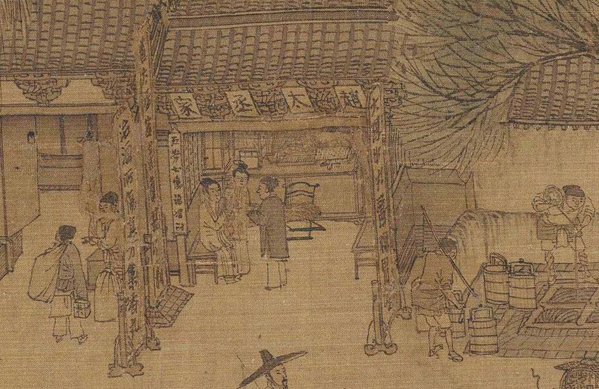How China handled epidemics through ages

A detail from “Along the River During the Qingming Festival” by the Song Dynasty painter Zhang Zeduan, depicts a doctor talking to his patients—two women and a baby in one’s arms—in a clinic. The term “tai cheng” (太丞) on the signboard indicates that this clinic is owned by an imperial doctor. Photo: FILE
Over thousands of years, continuous advances in anti-epidemic measures as well as the ever-improving state’s system and capacity for governance have played an important role in helping the Chinese overcome hardships and difficulties.
Legislative approaches
Epidemics can severely harm public health and affect tax revenue. All through the ages lawmakers have specified the reporting of epidemic outbreaks as one of the most important national issues in law, requiring all local officials to present information concerning epidemics to the court, and every yi zhan (post offices in ancient China, used mostly as relay points for couriers of official documents to rest and change horses) should serve the postal service without delay. According to the Great Ming Code (the legal code of the Ming empire), anyone who failed to report an epidemic outbreak was to be sentenced to a zhang punishment of 80 strikes (zhang referred to being beaten with a heavy stick, a common means of corporal punishment in ancient China). Local officials were also required by law to carefully measure the damage caused by epidemics, while any concealment or omission was strictly forbidden, so as to ensure that the court could better understand the situation and make informed decisions. The Great Ming Code also urged local officials to conduct field investigations in disaster-stricken areas and to reduce taxes on agriculture; those who failed to perform their duties were to be treated as if caught cheating and subjected to punishment.
In order to motivate officials to work more efficiently in dealing with epidemic outbreaks, the court often dispatched imperial envoys, such as jiancha yushi (investigative censors), to inspect and direct the local officialdom and their anti-epidemic measures. Local officials’ performance in handling outbreaks was often used as one of the indicators in performance appraisal.
During epidemic outbreaks, the emperor often required the local officials to carry out benevolent governance, taking care of victims. In 1457, Emperor Yingzong of Ming issued policies emphasizing disaster relief efforts, asking local officials to provide relief to persons who had suffered from some form of disaster and to bury unclaimed exposed corpses. Under the law and orders from the court, local officials did a lot to help victims. After a disaster, local governments often applied to the court for financial assistance in the form of tax relief to help people recover in accordance with local conditions.
Disease prevention
In addition to anti-epidemic measures, Chinese authorities established a set of prevention systems throughout the ages, involving medical management, publication of health books, construction of food storage facilities and improvements in judicial processes.
After the Han Dynasty (202 BCE–220 CE), medical institutions and academies were gradually established, including Tai Yi Shu (the Imperial Medical Office, focusing on training physicians in various fields of medicine; it originated in the Southern and Northern Dynasties and reached its peak during the Tang Dynasty), Tai Yi Ju (the Imperial Medical Bureau, in charge of medical education and services during the Song Dynasty) and Tai Yi Yuan (the Imperial Medical Academy, which originated in the Jin Dynasty between 1115 and 1234, providing medical services for the upper class). These institutions sent medical staff to the sites of outbreaks.
Rules for medical administration have existed since the Western Jin Dynasty (266–316). Later, the Tang Empire made a set of rules known as the Yi Ji Ling (Decree on Medicines), giving specified and detailed instructions on how to train and manage medical staff as well as the procurement and storage of medicines. During the Ming Dynasty (1368–1644), the court ordered the establishment of government-funded medical facilities across the country, purchasing herbs on government expense, offering medicine and treatment to the poor during epidemics. Opening medical schools to train doctors was another step taken by the Ming court in order to benefit its people. The Qing court adopted the Ming medical system and widely established local medical facilities to help the common people.
In order to disseminate public health information, the authorities collected, reviewed and published healthcare books. In 1057, Emperor Renzong of Song ordered the establishment of a bureau to recruit outstanding doctors for collecting and editing medical texts that had been passed down through the ages. Some influential works dating back to preceding dynasties, such as Shang Han Lun (On Cold Damage), Jingui Yaolüe (Synopsis of Prescriptions of the Golden Chamber) and Qianjin Yaofang (Remedies Worth their Weight in Gold), were carefully edited and issued nationwide.
During the Ming and Qing dynasties, under the orders from the court, local governments built many storehouses, yubei cang (for disaster relief rations) and changping cang (used to stabilize food prices). They could be used to provide food assistance to households with food shortages or damage caused by natural disasters or epidemics.
Considering how prisons frequently experienced a high rate of disease in summer, authorities of the Ming and Qing dynasties adopted a special judicial procedure known as re shen (retrial in hot season from the fourth lunar month to the sixth lunar month) to protect prisoners from potential diseases. Re shen was conducted in the fourth lunar month every year. The judicial departments heard or reheard cases, and the prisoners under sentence of tu (a punishment consisting of forced labor and restricted freedom), exile or lighter penalties might obtain a lower penalty or release on bail.
The article was edited and translated from Guangming Daily. Zhang Jinfan is a tenured professor from China University of Political Science and Law. Wang Bintong is a doctoral student from China University of Political Science and Law.
edited by REN GUANHONG
